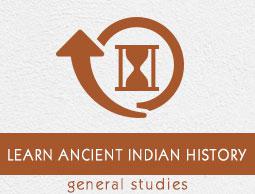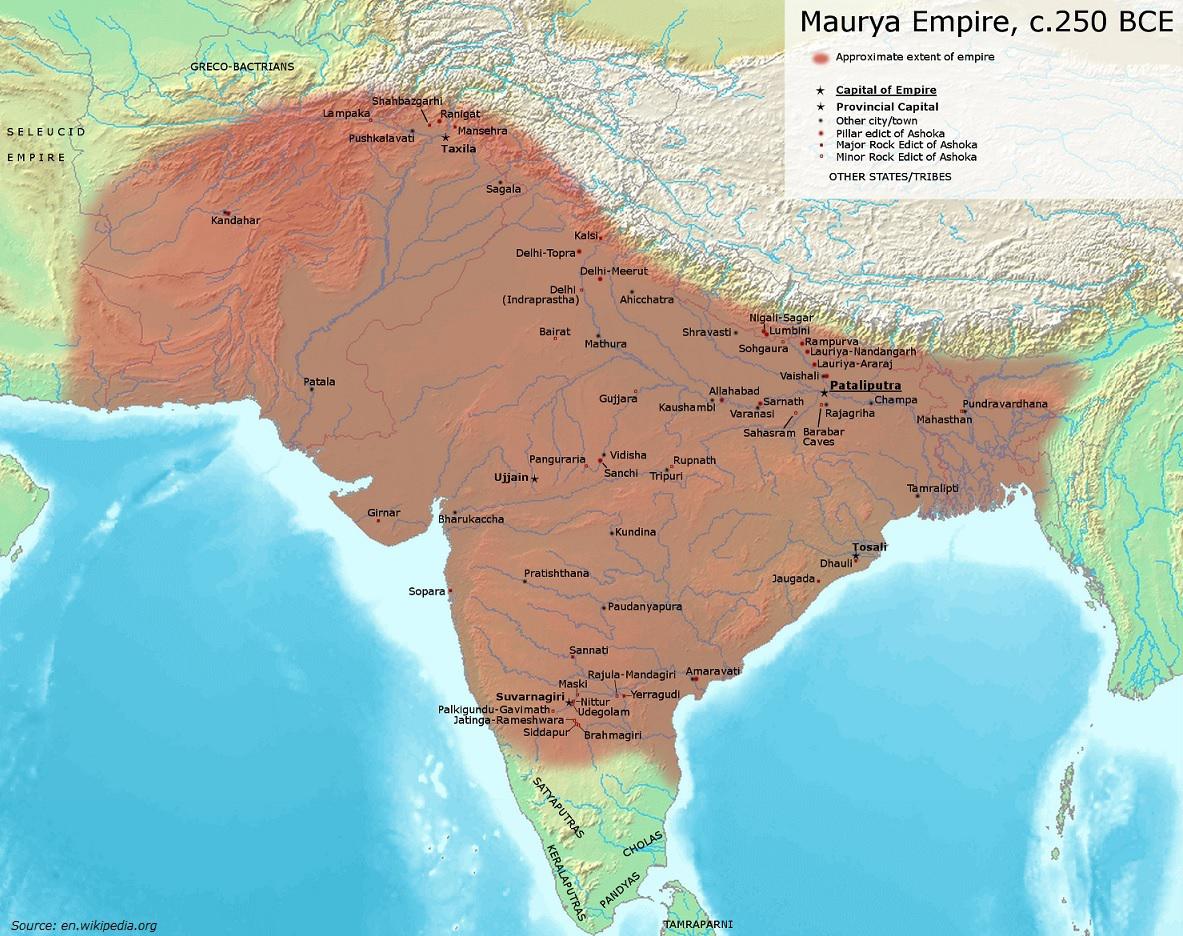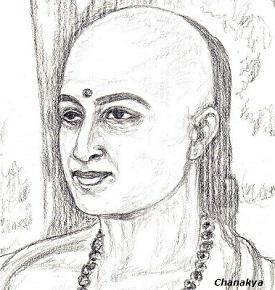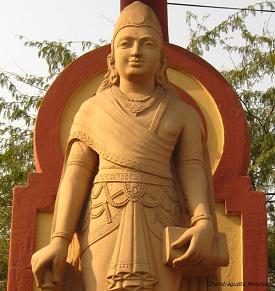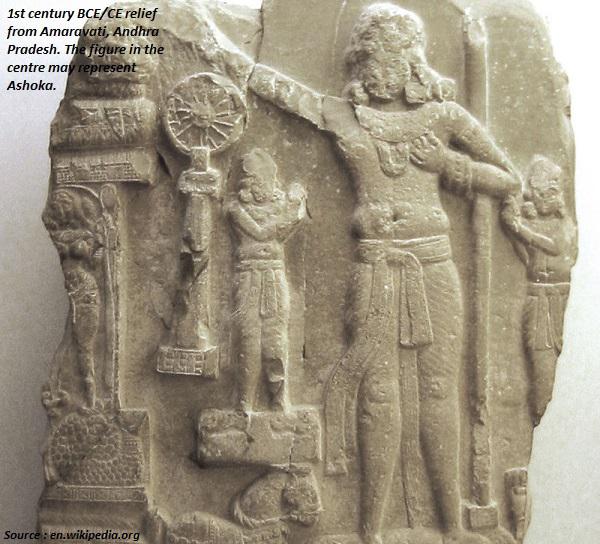Chandragupta took advantage of the disturbances caused by the invasion of Alexander and his sudden death in 323 B.C. in Babylon.
With the help of Kautilya, Chandragupta raised a large army and launched campaigns. He first overthrew the Greek kshatrapas ruling in the region of north-western India.
Greek writer Justin, writes, "India after the death of Alexander, had shaken, as it were, the yoke of servitude from its neck and put his Governors to death, and the architect of this liberation was Sandrocottas.”
The Sandrocottas mentioned in the Greek literature has been identified with Chandragupta Maurya.
After liberating north-western India from the Greek rule, Chandragupta turned his attention towards the conquest of Magadha (where Nanda was the Emperor). However, the details of this conquest are not known.
According to Parisistha-parvam (the Jain text), Chandragupta with the help of Chanakya, defeated the Nanda king and captured his empire and became the great ruler of Magadha empire.
Ashoka and his father Bindusara (son of Chandraguptha Maurya) did not make any conquest in south India. Therefore, it was Chandragupta Maurya who made it.
The Junagarh rock inscription describes that a dam for irrigation was constructed on the Sudarshana Lake by Pushyagupta, a provincial governor of Chandragupta Maurya.
Inscriptions of Ashoka found at Girnar hills in Junagarh district in Gujarat and at Sopara, in Thane district in Maharashtra reflect that these areas were under the rule of Mauryan Empire.
In south India, Ashoka's inscriptions have been found at Maski, Yerragudi, and Chitaldurga in Karnataka.
Rock Edict II and XIII of Ashoka explain that Chandragupta’s immediate neighboring states (in the south) were Cholas, Pandyas, Satyaputras, and Keralaputras.
The Jain tradition confirms that in his old age, Chandragupta abdicated the throne and retired to Shravanabelagola in Karnataka with his teacher Bhadrabahu (a Jain ascetic).
Local inscriptions of the later period mentioned that Chandragupta gave up his life as a Jaina devotee by fast unto death at a hill, which later on called as Chandragiri, seems to be named after him.
In about 305 B.C. Chandragupta defeated the army of the Greek Kshatrapa Seleucus who had succeeded Alexander in the eastern part of his empire.
The Greek writers stated that a treaty was concluded between Seleucus and Chandragupta in which Seleucus accepted the territories of Kandahar, Kabul, Herat, and Baluchistan and Chandragupta presented him 500 elephants.
The treaty was followed by a matrimonial alliance between the two in which Seleucus married his daughter to Chandragupta Maurya or to his son Bindusara.
Seleucus sent Megasthenese as his ambassador to the court of Chandragupta.
Plutarch writes, "Sandrocottas who had by that time mounted the throne overran and subdued the whole of India with an army of 600,000".
It is clear that Chandragupta had established a vast empire extended from Afghanistan in the west to Assam in the east and from Kashmir in the north to Karnataka in the south. The entire country except Kalinga was under his rule.
Bindusara (son of Chandragupta), did not make any conquests. Thereafter, Ashoka (son of Bindusara) is said to have added only Kalinga to the Mauryan-empire.
Chandragupta Maurya had ruled for 24 years i.e. from 324 B.C. to 300 B.C.
Bindusara, the son of Chandragupta Maurya, ascend to throne after his father.
According to the Tibetan historian, Taranath, Chanakya continued as a minister of Bindusara after Chandragupta Maurya. Hemachandra, Jain scholar, also confirms this fact.
Divyavadana mentions that Bindusara appointed his eldest son Sumana (or Susima) as his viceroy at Taxila and Ashoka at Ujjain. It also mentions that when a revolt broke out at Taxila, Ashoka was sent to restore peace as Susima fails to suppress it.
Bindusara continued his policy of friendly relations with Hellenic world.
Dionysius was the Egypt ambassador came to the court of Bindusara.
Pliny mentions that Ptolemy Philadelphus, king of Egypt sent him as an ambassador.
Bindusara had been given the credit of south Indian conquest, but most of the scholars believe that this was done by his father Chandragupta Maurya.
Ashoka himself speaks affectionately about his brothers, sisters, and relatives in his edicts.
Ashoka was the first king in the Indian history who has left his records engraved on stones.
The history of Ashoka’s reign can be reconstructed with the help of his inscriptions and some other literary sources.
The Ashokan inscriptions are found at 47 places in different regions of India, Nepal, Pakistan, and Afghanistan.
The inscriptions on rocks are called as the ‘Rock Edicts,’ and those on Pillars, ‘Pillar Edicts.’
Ashoka’s name occurs only in copies of Minor Rock Edict-I found at three places in Karnataka and one in Madhya Pradesh. Whereas in all other inscriptions, he mentioned himself as ‘Devanampiya’ and ‘Piyadasi’ meaning beloved of the gods.
Ashoka ‘s inscriptions were written in four different scripts, namely −
Greek languages and scripts used in Afghanistan area;
Aramaic languages and scripts used in west Asia;
Prakrit language and Kharosthi script used in Pakistan area; and
Prakrit language and Brahmi script used in rest of the inscriptions.


